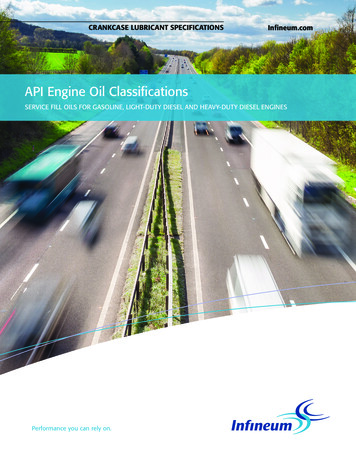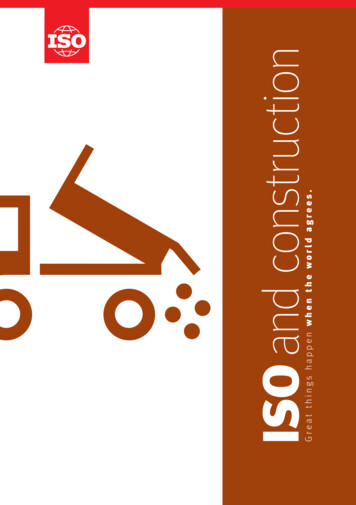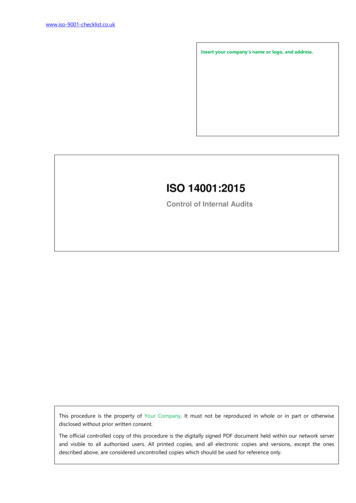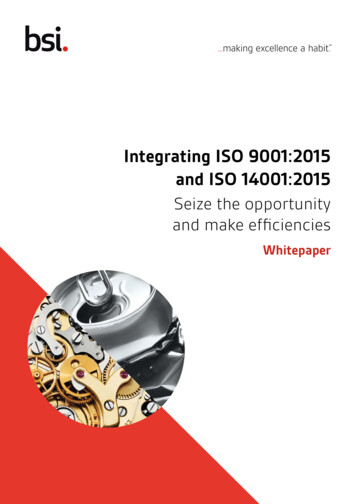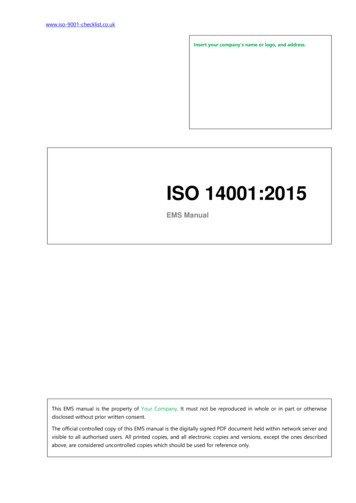
Transcription
QUICK GUIDEISO Construction ClassificationsFor more information visit, www.assetworks.com/riskCopyright 2016 AssetWorks Inc. All Rights Reserved.
ISO Construction ClassificationsUnderstanding the construction classifications outlined by the Insurance Services Office is important for builders,appraisers, underwriters and just about anybody invested in the life of a building. The factors that go directly intounderstanding the ISO’s construction classifications are the materials used in the construction of the building,and whether or not they’re combustible.In this Quick Guide, we will explore the fundamentals of the Insurance Service Office’s constructionclassifications. The guide will provide a detailed explanation of the origins of the classifications and the elementsmaking up each classification. For easy reference, the Quick Guide has been divided into multiple sections aslisted below.SECTION 1 ‐ History of the ISOSECTION 2 ‐ Overview of the ISO Construction ClassificationsSECTION 3 ‐ Breaking down the ISO Construction ClassificationsSECTION 4 – Why ISO Construction Classifications matter2For more information visit, www.assetworks.com/riskCopyright 2016 AssetWorks Inc. All Rights Reserved.
SECTION 1History of the Insurance Services OfficeFor more information visit, www.assetworks.com/riskCopyright 2016 AssetWorks Inc. All Rights Reserved.
ISO Construction ClassificationsHistory of the Insurance Services OfficeA starting pointFormed in 1971, the Insurance ServicesOffice jumped into the business as anadvisory and rating organization dealing withproperty/casualty insurance. The ISOspecialized in statistical and actuarialservices, developing insurance programs andassisting insurance companies in meetingState regulatory requirements.Joining forcesIn 2009, the ISO became a subsidiary of New Jersey‐based Verisk Analytics, a dataanalytics and risk assessment firm.4For more information visit, www.assetworks.com/riskCopyright 2016 AssetWorks Inc. All Rights Reserved.
ISO Construction ClassificationsHistory of the Insurance Services OfficeWhat’s the role of the ISO?According to Bloomberg, the Insurance Services Office “offers information and analytics forinsurance risks.” The media company broke it down into specifics in its ISO company profile,noting “the company provides statistical, actuarial, underwriting and claims information, policylanguage, fraud‐identification tools and various other technical services.”A global reachAlthough the Insurance Services Office islocated in the United States, it servescustomers across the world. The ISO doeswork for companies in the United Kingdom,China, Israel, Germany and India, to namea few.5For more information visit, www.assetworks.com/riskCopyright 2016 AssetWorks Inc. All Rights Reserved.
SECTION 2Overview of the ISO Construction ClassificationsFor more information visit, www.assetworks.com/riskCopyright 2016 AssetWorks Inc. All Rights Reserved.
ISO Construction ClassificationsOverview of the ISO Construction ClassificationsDetermining a construction classificationUnderstanding ISO construction classifications is important for builders, property owners orappraisers. The classifications correlate with the combustibility of a building, meaning how well astructure will do in a fire. There are two important factors in determining a constructionclassification:Building elements: The materials used in theconstruction of the structural frame, exterior andinterior bearing walls, exterior and interior nonbearingwalls and partitions, floor construction (includingsupporting beams and joists) and roof construction(supporting beams and joists)Fire‐resistance rating: In construction classifications,a fire‐resistance rating is usually measured in time.It’s the amount of time a passive fire protectionsystem can withstand a standard fire‐resistance test.Not all of the construction classifications carry fire‐resistance ratings.For more information visit, www.assetworks.com/riskCopyright 2016 AssetWorks Inc. All Rights Reserved.7
ISO Construction ClassificationsOverview of the ISO Construction ClassificationsDeveloping an ISO checklistNow that we know the two factors that are used to determine ISO constructionclassifications, let’s take it a step further. To properly classify a building according to ISOconstruction classes, you’ll need to be able to answer the following questions:1. What materials make up the frame?2. What materials make up the interiorand exterior bearing walls?3. What materials make up thefloor construction?4. What materials make up theroof construction?5. What is the fire rating of these materials?8For more information visit, www.assetworks.com/riskCopyright 2016 AssetWorks Inc. All Rights Reserved.
SECTION 3Breaking down ISO Construction ClassificationsFor more information visit, www.assetworks.com/riskCopyright 2016 AssetWorks Inc. All Rights Reserved.
ISO Construction ClassificationsBreaking down the ISO Construction ClassificationsIntroducing the ISO classificationsFrameJoisted MasonryMasonry NoncombustibleModified Fire ResistiveFor more information visit, www.assetworks.com/riskNoncombustibleFire ResistiveCopyright 2016 AssetWorks Inc. All Rights Reserved.10
ISO Construction ClassificationsBreaking down the ISO Construction ClassificationsFrameSummary:Buildings with interior walls, exterior walls, floorsand roofs made with combustible materials(usually wood). However, some exterior walls maybe constructed with noncombustible or slow‐burning materials. The use of masonry veneerand metal clad do not change the construction.Fire‐resistance rating: NoneAdvantages: Easy to erect, economicalExamples: Housing, with no morethan 3‐4 stories11For more information visit, www.assetworks.com/riskCopyright 2016 AssetWorks Inc. All Rights Reserved.
ISO Construction ClassificationsBreaking down the ISO Construction ClassificationsJoisted MasonrySummary:Buildings in which combustible materials likewood are combined with other materials suchas brick or stone veneer, wood iron clad orstucco. Concrete block, masonry or reinforcedmasonry load bearing exterior walls also fit intothis classification. Typically these buildings areconstructed with wood frames, roofs andfloors.Fire‐resistance rating: Not less than 1 hourAdvantages: Harder to ignite, more structuralstabilityExamples: housing, small office or retail spaceswith no more than 3‐4 stories12For more information visit, www.assetworks.com/riskCopyright 2016 AssetWorks Inc. All Rights Reserved.
ISO Construction ClassificationsBreaking down the ISO Construction ClassificationsNoncombustibleSummary:Buildings with exterior walls, floors, roofsand supports made up of slow‐burning andnoncombustible materials. Steel frames arecommon in this classification, and mixed inwith masonry fill, brick veneer, metalsheathing and an exterior insulation finishingsystem. In multi‐story noncombustibleconstruction, floors are concrete on a steelframe with a steel deck.Fire‐resistance rating: NoneAdvantages: Easy to erect, economicalExamples: Warehouses and manufacturingfacilities13For more information visit, www.assetworks.com/riskCopyright 2016 AssetWorks Inc. All Rights Reserved.
ISO Construction ClassificationsBreaking down the ISO Construction ClassificationsMasonry NoncombustibleSummary:Buildings in which the exterior walls areconstructed of masonry materials, not lessthan four inches thick. The floor and roof areconstructed with metal or othernoncombustible materials. Generally, concreteblock, reinforced masonry or tilt‐up concretewalls are combined with heavy steel framing.Fire‐resistance rating: Not less than 1 hourAdvantages: Uses materials that don’treadily burnExamples: Shopping centers, strip malls, officebuildings, warehouses and schools14For more information visit, www.assetworks.com/riskCopyright 2016 AssetWorks Inc. All Rights Reserved.
ISO Construction ClassificationsBreaking down the ISO Construction ClassificationsModified or Semi‐Fire ResistiveSummary:Buildings with exterior walls, floors androofs made up of masonry materials that areno less than four inches thick. Exteriornonbearing walls and panels may be slow‐burning or combustible. Protected steel,concrete or heavy masonry walls and floorsare common in this classification.Fire‐resistance rating: Less than 2 hours, butgreater than 1 hourAdvantages: Allows greater height and areaExamples: High and mid‐rise office buildingsand condos15For more information visit, www.assetworks.com/riskCopyright 2016 AssetWorks Inc. All Rights Reserved.
ISO Construction ClassificationsBreaking down the ISO Construction ClassificationsFire ResistiveSummary:This classification requires walls of masonrymaterials, including reinforced concrete, not lessthan four inches thick. Hollow masonry is apossibility, but not less than eight inches thick.Exterior bearing walls must be made ofnoncombustible materials, but exteriornonbearing walls may be built from combustiblematerials.Fire‐resistance rating: Not less than 2 hoursAdvantages: Uses load‐bearing materialsthat resist fireExamples: High‐rise office buildings, condosor parking garages16For more information visit, www.assetworks.com/riskCopyright 2016 AssetWorks Inc. All Rights Reserved.
SECTION 4Why ISO Construction Classifications matterFor more information visit, www.assetworks.com/riskCopyright 2016 AssetWorks Inc. All Rights Reserved.
ISO Construction ClassificationsWhy ISO Construction Classifications matterEstablishing Replacement CostsReplacement cost is the amount required to replace an entire property in like size, kind, andquality. ISO Construction Classifications help provide an understanding of the materials used toconstruct the building – a major factor in calculating replacement cost.Determining Susceptibility to RiskWhile ISO construction classifications are based on the combustibility of the structure, the factorsthat go into determining the classification can be used by catastrophe modeling programs toanalyze how likely a building is to sustain losses due to fire, windstorm, or seismic risk events.Example: A tale of two Construction ClassesA building with the construction classification “frame” is likely to have a lower replacement costthan a similar building with the construction classification “joisted masonry.” However, while itmay be less expensive to build, the Framed construction might be more susceptible to risk thanJoisted Masonry.18For more information visit, www.assetworks.com/riskCopyright 2016 AssetWorks Inc. All Rights Reserved.
ISO Construction ClassificationsAssetWorks Can HelpDon’t let ISO construction classifications get you down! For decades, AssetWorks hasbeen helping organizations, large and small, in the property appraisal process. Our teamof experts can help gather the critical building attributes needed for everything fromdetermining ISO construction class to catastrophe modeling. Our software solutionshelp bridge the gap between the collection and management of building characteristicsand valuation data.If you have questions about maintaining detailed building records for risk managementpurposes, one of our experts would be happy to help. To get the conversation started,simply contact AssetWorks today at 1‐877‐809‐0600 or info@assetworks.com.19For more information visit, www.assetworks.com/riskCopyright 2016 AssetWorks Inc. All Rights Reserved.
ISO Construction Classifications Understanding the construction classifications outlined by the Insurance Services Office is important for builders, appraisers, underwriters and just about anybody invested in the life of a building. The factors that go directly intoFile Size: 1023KBPage Count: 19Explore furtherBuilding Construction Categories (ISO) Insurance .www.irmi.comDetermining ISO Construction Types - TWIAwww.twia.orgISO 1-6 Descriptionswww.jfwins.comUPFRO - ISO Construction Class Definitionswww.upfro.comWhat are ISO building construction codes 1-6? - Answerswww.answers.comRecommended to you b

